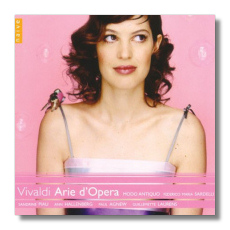
The Internet's Premier Classical Music Source
Related Links
- Vivaldi Reviews
- Latest Reviews
- More Reviews
-
By Composer
-
Collections
DVD & Blu-ray
Books
Concert Reviews
Articles/Interviews
Software
Audio
Search Amazon
Recommended Links
Site News
 CD Review
CD Review
Antonio Vivaldi

Volume 27
- Arias from
- Tieteberga
- La Candace
- La Silvia
- Tito Manlio
- La verità in cimento
- Médea e Giasone
Sandrine Piau, soprano
Ann Hallenberg, Guillemette Laurens, mezzo-sopranos
Paul Agnew, tenor
Modo Antiquo/Federico Maria Sardelli
Naïve OP30411 DDD 64:44
This is another volume – Volume 27, in fact! – in Naïve/Opus 111's ongoing series of music by Vivaldi – specifically, manuscripts located in the National University Library in Turin. At first glance, this might appear simply to be a "greatest hits" collection from Vivaldi's operas, but the truth is a little more unusual than that. Volume 28 in Turin's so-called "Foà Collection" contains 47 operatic arias or ensembles composed by Vivaldi between 1717 and 1721. How did they get there? The answer is that Vivaldi himself probably put them there. But why would Vivaldi do this? Two possible explanations are proffered. One is that such a collection would provide Vivaldi, then traveling extensively, with raw materials for assembling a new opera or pastiche. Another is that Vivaldi simply wanted to set aside some of his most attractive and marketable material for sale, one aria at a time, to interested individuals. Of course these explanations are not mutually exclusive. At any rate, Foà 28 is a treasure trove of arias for different voices and different dramatic situations. Not exactly a "greatest hits" collection, then, but a great and varied collection nevertheless.
This selection of 16 arias or ensembles contains its share of familiar genres. "Io son frà l'onde" is an example of the classic aria di tempesta in which the singer compares herself to a ship tossed about on the ocean during a terrifying storm. Three of the arias – "Zeffiretti che sussurate," "Usignoli che piangete," and "Quell'augellin che canta" – contain bird imitations in both the vocal line and in the accompaniment. There are arias of revenge and arias of regret. Vivaldi's creativity runs high throughout, and there's nothing dull here – as one might expect from a special collection of this sort. Much of the writing is florid almost to the point of sadism towards the singers, but apparently Vivaldi had many talented musicians at his disposal.
Lately, we complain about the dearth of great singers. It's true, there is no one like Maria Callas and Luciano Pavarotti singing today, but we are fortunate that in 2005, so many singers excel in the Baroque repertoire. Hearing Piau, Hallenberg, Agnew, and Laurens is enough to make one's jaw drop. In particular, Piau is very impressive in her negotiation of Vivaldi's most ornamented passages, and Agnew's masculine timbre confounds the stereotype of the Baroque tenor as being an effete sort of fellow. Sardelli's leadership is bold and spicy – a fitting complement to the singing. The booklet notes are well worth reading, and we even get texts and translations of all the selections. Engineering? First class, like everything else about this release. This might look like a CD for specialists only, but anyone who loves the human voice and who wants to move past The Four Seasons will get a huge kick out of this, I bet.
Copyright © 2005, Raymond Tuttle



















